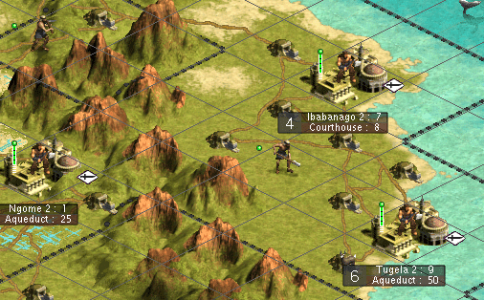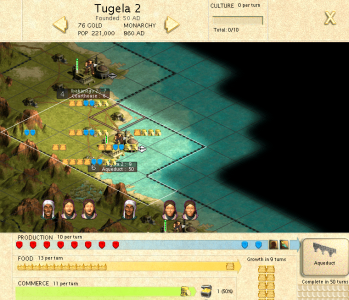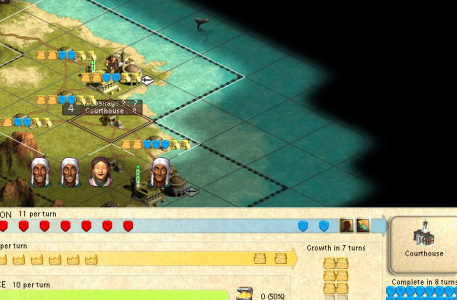Thank you, I have read this one, it does not state specificaly the answer.Some information in this thread https://forums.civfanatics.com/threads/pollution-control.672882/#post-16149051
You are using an out of date browser. It may not display this or other websites correctly.
You should upgrade or use an alternative browser.
You should upgrade or use an alternative browser.
Quick Answers / 'Newbie' Questions
- Thread starter Turner
- Start date
With a specific image file editor, such as gimp.Thought of this after viewing another thread. Is there a way to change the color of Flood Plain tiles so as to easily differentiate them from Desert tiles? Obviously not a big deal, but curious.
Or find an existing terrain file you like in the Customization part of the forum.
From the top of my head I dont know which are better at differentiating flood plains from desert though.
WeirdoJoker
King
How is this done? I assume some file needs a minor edit?The Original Flood Plains file, for example, can be easily changed to a more saturated color because the surrounding color of the tiles are transparent that allows the normal Desert terrain to show.
WeirdoJoker
King
Thanks. Downloaded GIMP and am trying now. It's going to take a while to figure out how it works exactly.WeirdoJoker... in the Game Art Folder, the Terrain Folder contains the Terrain Files.
A Graphics Editing program can be used to change the Palette for the floodplains.pcx file.
There are some tools that could make it easy, depending on exactly what you want to do. I would suggest looking at the colours menu, particularly the map sub menu, perhaps rotate colous tool.Thanks. Downloaded GIMP and am trying now. It's going to take a while to figure out how it works exactly.
Changing or adjusting the Palette colors is easy and fast but you do need to know the Graphics program you are using and exactly what you want to do.
You can simply do an experiment... change the entire palette colors by increasing the Color Saturation then look at it in Game.
Then if some of the colors need to be kept as they were such as the surrounding light yellow colors, that can be done in several ways.
Example: Open the Original Palette, Take a Screen Shot of it and paste it as a new image. Save it as a .bmp (Best for accurate Colors).
Then you can add the original colors you want back to the Changed Palette.
You can simply do an experiment... change the entire palette colors by increasing the Color Saturation then look at it in Game.
Then if some of the colors need to be kept as they were such as the surrounding light yellow colors, that can be done in several ways.
Example: Open the Original Palette, Take a Screen Shot of it and paste it as a new image. Save it as a .bmp (Best for accurate Colors).
Then you can add the original colors you want back to the Changed Palette.
My Zulus just got monarchy in 2350 BC (round 35) on emperor through huts, lol. I have 3 cities, 2 of them at size 1. Is this a record or something? What is the most extreme you have ever seen? I made no re-load and I have ancient-tech trading deactivated. I wonder when is the right time to have a revolution...

Last edited:
I wonder when is the right time to have a revolution
Now. I sometimes delay for a turn or two to let a settler build to complete, but otherwise, as soon as you reach your target government, revolt. Then you can irrigate grassland profitably, and ideally, you have a small amount of irrigated tiles just before the revolution even, ready for growth once you finish the revolution.
OK, my position already has 3 food bonuses, a luxury and monarchy (it IS my target government) is going to work properly I guess...food is king here with so much land to settle, right? No big deal for a few unit support coins per turn.Now. I sometimes delay for a turn or two to let a settler build to complete, but otherwise, as soon as you reach your target government, revolt. Then you can irrigate grassland profitably, and ideally, you have a small amount of irrigated tiles just before the revolution even, ready for growth once you finish the revolution.
I am a bit sceptical at your statement though, as far as republic is concerned, I have seen various under-developed positions where I think republic leads to a financial disaster, but that deserves a seperate thread I guess.
I am a bit sceptical at your statement though, as far as republic is concerned, I have seen various under-developed positions where I think republic leads to a financial disaster, but that deserves a seperate thread I guess.
When going to Republic early, at most it usually becomes a lower research rate in terms of percentage sometimes basically. But, it's rarely less science or soon won't be. All economic shortfalls don't last long AND they get compensated for by early growth. The only reason I don't revolt immediately lies in that my capital can often grow in anarchy if they put out a settler right before it. If my core city(ies) just produced a settler or worker, the revolution might even come using "what's the big picture" on the inter-turn.
In your screenshot in despotism you currently have 3 surplus food per turn in Zimbabwe; one from the grassland cow and two from natural citizens. I'm kind of surprised it wasn't already irrigated, but whatever.
Once you become a Monarchy, you get back the extra food from the game AND the grassland cow. That will give Zimbabwe 5 food per turn! Assuming it already has a granary, that gives it 2 turn growth.
And soon that grassland cow could get irrigated while some new city on a hill north of Zimbabwe could use that game.
So, why hesitate here? Monarchy clearly has the superior position in the right hands at least.
Really, how does Monarchy ever have an inferior position? Honestly, if my civilization had Republic or Monarchy on the first turn, I'd just revolt right away and irrigate bonus grassland tiles up to 5 food per turn in core cities, if not grassland tiles up to that point also. Oh, it also helps to have "emphasize production" on, with all other settings off. Then reset any forest usage on growth to 2 food per turn tiles.
Perhaps you do not need irrigated grasslands. You may have little or no fresh water. You may have a river in plains or a mostly plain empire. Aqueducts may be far away in tech tree and cities are already size 5 or something. You may have only a couple of despotism penalties. You may work a lot of unroaded, unrivered tiles, because you did not create enough workers. Again. Perhaps you have 4 units per city or even more because you border Montezuma. Again. Perhaps all your core cities are building libraries and marketplaces. Perhaps you have no luxuries and two reg warriors in every city. I can recall a few games I regretted going republic too early. Rare, but not impossible.When going to Republic early, at most it usually becomes a lower research rate in terms of percentage sometimes basically. But, it's rarely less science or soon won't be. All economic shortfalls don't last long AND they get compensated for by early growth. The only reason I don't revolt immediately lies in that my capital can often grow in anarchy if they put out a settler right before it. If my core city(ies) just produced a settler or worker, the revolution might even come using "what's the big picture" on the inter-turn.
I started 7 of Zimbabwe and moved my settler. Began mining the original tile (bonus grassland) without moving the worker, before seeing the cow. Then I decided to work on the luxury in the forest at 4, which was in harmony with my granary (perhaps a mistake?). After that, I am going to lose a tempo crossing the river, so I moved to the only sensible tile that made sense to be roaded, the BG 1 of Zimbabwe. I also mined it (unclear decision), then I began irrigating towards the cow through the plain tile (I couldn't imagine getting monarchy by a hut at this point). Perhaps one or more of my actions are wrong under more careful analysis, but they made some kind of sense when I took them.In your screenshot in despotism you currently have 3 surplus food per turn in Zimbabwe; one from the grassland cow and two from natural citizens. I'm kind of surprised it wasn't already irrigated, but whatever.
Yes, you are right. It rocks. Zimbabwe becomes a 4-turn settler factory as it is, as soon as I enter monarchy. In size 3 and only using a worked tile!Once you become a Monarchy, you get back the extra food from the game AND the grassland cow. That will give Zimbabwe 5 food per turn! Assuming it already has a granary, that gives it 2 turn growth.
And soon that grassland cow could get irrigated while some new city on a hill north of Zimbabwe could use that game.
So, why hesitate here?
Yes, monarchy is probably ALWAYS better than despotism.Monarchy clearly has the superior position in the right hands at least.
Really, how does Monarchy ever have an inferior position?
Last edited:
Aqueducts may be far away in tech tree and cities are already size 5 or something.
So?
You may work a lot of unroaded, unrivered tiles, because you did not create enough workers.
I make more workers then! Worker shortages don't last long for me usually.
Yes, monarchy is probably ALWAYS better than republic.
Maybe you meant Monarchy is probably always better than Despotism? Because Republic is better than Monarchy for research and most other purposes.
You are lying.I make more workers then! Worker shortages don't last long for me usually.
 NOONE ever has enough workers. If he creates 7000, it will turn out he needed 7500. It is known.
NOONE ever has enough workers. If he creates 7000, it will turn out he needed 7500. It is known.Yes, thanks, I fixed itMaybe you meant Monarchy is probably always better than Despotism? Because Republic is better than Monarchy for research and most other purposes.
Does anyone know? Does a mined desert square work like a forest in a settler factory?

Imagine that I mine one of the irrigated grasslands so that I get 5 fpt and 6spt. All remaining grasslands (including the one that is used by the other city) are non-bonus ones. I can mine one of them so as to get 5f-7s at size 5. Can I make a 4-turn settler factory at size 4 by using a mined desert tile during the growing rounds or the governor, despite having orders to emphasize production, is going to pick up the 2f-1s grassland instead? Has anyone tried that?
Imagine that I mine one of the irrigated grasslands so that I get 5 fpt and 6spt. All remaining grasslands (including the one that is used by the other city) are non-bonus ones. I can mine one of them so as to get 5f-7s at size 5. Can I make a 4-turn settler factory at size 4 by using a mined desert tile during the growing rounds or the governor, despite having orders to emphasize production, is going to pick up the 2f-1s grassland instead? Has anyone tried that?
templar_x
usually walks his talks
The governor will pick the mined desert tile, yes. I have often used that already.
t_x
t_x
Thanks, that is good to hear, I do not have fresh water/aqueduct to go higher.The governor will pick the mined desert tile, yes. I have often used that already.
t_x



